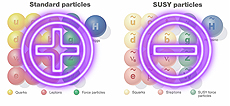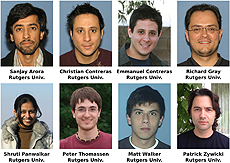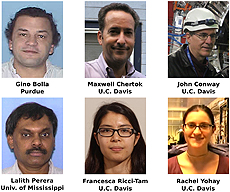R-parity violation
 |
Not only would the discovery of supersymmetry double the number of known particles, but it would introduce a new type of charge: Standard Model particles have positive R-parity and supersymmetric particles have negative R-parity.
|
Many of the CMS results presented in this column involve supersymmetry, the idea that there is a deep relationship between matter and forces. If nature is supersymmetric, then for each type of matter particle, there would be a corresponding supersymmetric force, and for each of the four forces, there would be a corresponding particle of supersymmetric matter. No evidence of supersymmetry has yet been found, despite the fervent searches, so you might be wondering why scientists are still looking for it. There are two reasons: (1) It would greatly increase our understanding of how all known particles unify, and (2) there are so many different ways that supersymmetry might manifest itself that the searches performed so far are not exhaustive.
To illustrate this complexity, let's examine one property that a supersymmetric theory might or might not have, known as R-parity. R-parity is a property of particles in the same sense as electric charge. Just as protons are positively charged and electrons are negatively charged, all currently known particles have positive R-parity, and their supersymmetric variants, if they exist, would have negative R-parity. R-parity is the supersymmetric-ness of a particle. Supersymmetric theories come in two broad classes: those in which the R-parity of a system is constant, like electric charge, and those in which R-parity can change with time.
Not only would the constancy or variation of R-parity reveal something fundamental about supersymmetry, but it has implications for the way scientists search for it. If R-parity is constant, then at least one supersymmetric particle must be stable. It cannot decay into normal matter because that would flip its R-parity from negative to positive. This feature could explain dark matter, because the stable supersymmetric particle would be dark (invisible). It also means that supersymmetric particles would appear as missing energy in a particle detector like CMS, due to their invisibility. Most searches for supersymmetry look for this characteristic energy imbalance.
If, on the other hand, R-parity is not constant, then all supersymmetric particles could decay, and searches based on missing energy would not find them. For this reason, a team of CMS physicists performed a different kind of supersymmetry search, one that doesn't rely on missing energy. They used lepton count, b quark identification and the distribution of energy to distinguish supersymmetric events from the background.
What they measured is consistent with known physics, further rolling back uncertainty with hard data. When dealing with the unknown, one must leave no stone unturned.
—Jim Pivarski
 |
The physicists pictured above performed a search for R-parity violating supersymmetry.
|
 |
These U.S. physicists were involved in setting up a cleanroom at CERN to test CMS pixel detectors. The cleanroom allows scientists to fully test the equipment.
|
|